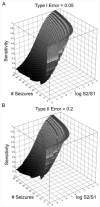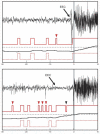A stochastic framework for evaluating seizure prediction algorithms using hidden Markov models
- PMID: 17021032
- PMCID: PMC2230664
- DOI: 10.1152/jn.00190.2006
A stochastic framework for evaluating seizure prediction algorithms using hidden Markov models
Abstract
Responsive, implantable stimulation devices to treat epilepsy are now in clinical trials. New evidence suggests that these devices may be more effective when they deliver therapy before seizure onset. Despite years of effort, prospective seizure prediction, which could improve device performance, remains elusive. In large part, this is explained by lack of agreement on a statistical framework for modeling seizure generation and a method for validating algorithm performance. We present a novel stochastic framework based on a three-state hidden Markov model (HMM) (representing interictal, preictal, and seizure states) with the feature that periods of increased seizure probability can transition back to the interictal state. This notion reflects clinical experience and may enhance interpretation of published seizure prediction studies. Our model accommodates clipped EEG segments and formalizes intuitive notions regarding statistical validation. We derive equations for type I and type II errors as a function of the number of seizures, duration of interictal data, and prediction horizon length and we demonstrate the model's utility with a novel seizure detection algorithm that appeared to predicted seizure onset. We propose this framework as a vital tool for designing and validating prediction algorithms and for facilitating collaborative research in this area.
Figures



Similar articles
-
A novel seizure detection algorithm informed by hidden Markov model event states.J Neural Eng. 2016 Jun;13(3):036011. doi: 10.1088/1741-2560/13/3/036011. Epub 2016 Apr 21. J Neural Eng. 2016. PMID: 27098152 Free PMC article.
-
Seizure prediction with spectral power of EEG using cost-sensitive support vector machines.Epilepsia. 2011 Oct;52(10):1761-70. doi: 10.1111/j.1528-1167.2011.03138.x. Epub 2011 Jun 21. Epilepsia. 2011. PMID: 21692794
-
Preictal period optimization for deep learning-based epileptic seizure prediction.J Neural Eng. 2024 Dec 27;21(6). doi: 10.1088/1741-2552/ad9ad0. J Neural Eng. 2024. PMID: 39637549
-
The role of high-quality EEG databases in the improvement and assessment of seizure prediction methods.Epilepsy Behav. 2011 Dec;22 Suppl 1:S88-93. doi: 10.1016/j.yebeh.2011.08.030. Epilepsy Behav. 2011. PMID: 22078525 Review.
-
Seizure detection, seizure prediction, and closed-loop warning systems in epilepsy.Epilepsy Behav. 2014 Aug;37:291-307. doi: 10.1016/j.yebeh.2014.06.023. Epub 2014 Aug 29. Epilepsy Behav. 2014. PMID: 25174001 Review.
Cited by
-
Toward rational design of electrical stimulation strategies for epilepsy control.Epilepsy Behav. 2010 Jan;17(1):6-22. doi: 10.1016/j.yebeh.2009.10.017. Epub 2009 Nov 17. Epilepsy Behav. 2010. PMID: 19926525 Free PMC article. Review.
-
Potential for unreliable interpretation of EEG recorded with microelectrodes.Epilepsia. 2013 Aug;54(8):1391-401. doi: 10.1111/epi.12202. Epub 2013 May 3. Epilepsia. 2013. PMID: 23647099 Free PMC article.
-
Computer modelling of epilepsy.Nat Rev Neurosci. 2008 Aug;9(8):626-37. doi: 10.1038/nrn2416. Epub 2008 Jul 2. Nat Rev Neurosci. 2008. PMID: 18594562 Free PMC article. Review.
-
Phase Coherent Currents Underlying Neocortical Seizure-Like State Transitions.eNeuro. 2019 Mar 22;6(2):ENEURO.0426-18.2019. doi: 10.1523/ENEURO.0426-18.2019. eCollection 2019 Mar-Apr. eNeuro. 2019. PMID: 30923739 Free PMC article.
-
Proposing a two-level stochastic model for epileptic seizure genesis.J Comput Neurosci. 2014 Feb;36(1):39-53. doi: 10.1007/s10827-013-0457-5. Epub 2013 Jun 4. J Comput Neurosci. 2014. PMID: 23733322
References
-
- Albert PS. A two-state Markov mixture model for a time-series of epileptic seizure counts. Biometrics. 1991;47:1371–1381. - PubMed
-
- Andrzejak RG, Mormann F, Kreuz T, Rieke C, Kraskov A, Elger C, Lehnertz K. Testing the null hypothesis of the nonexistence of a preseizure state. Phys Rev E. 2003;67:010901. - PubMed
-
- Andrzejak RG, Widman G, Lehnertz K, Rieke C, David P, Elger CE. The epileptic process as nonlinear deterministic dynamics in a stochastic environment: an evaluation on mesial temporal lobe epilepsy. Epilepsy Res. 2001;44:129–140. - PubMed
-
- Aschenbrenner-Scheibe R, Maiwald T, Winterhalder M, Voss HU, Timmer J, Schulze-Bonhage A. How well can epileptic seizures be predicted? An evaluation of a nonlinear method. Brain. 2003;126:2616–2626. - PubMed
-
- Dempster AP, Laird N, Rubin DB. Maximum likelihood from incomplete data via the EM algorithm. J R Stat Soc B. 1977;39:1–38.
Publication types
MeSH terms
Grants and funding
LinkOut - more resources
Full Text Sources
Other Literature Sources
Medical

